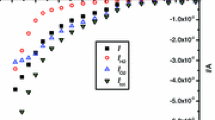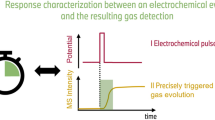Abstract
Herein online mass spectrometry is used to record real-time concentration curves of anodic gases released during the electrochemical oxidation of graphite anodes in molten CaCl2. The shape of these curves suggests that electrochemical oxidation is rate limited by the mass transport of oxidant ions to the anode surface. Anodic gas bubbles are formed and released from nucleation sites at this surface. Although the applied voltage is less than the decomposition voltage, an unexpectedly high release of Cl2 gas indicates continuous decomposition of molten CaCl2. The origin of experimentally observed anodic gas bubbling is explained using phase-field simulations of a rising gas bubble in molten CaCl2.





Similar content being viewed by others
References
C. Osarinmwian, I.M. Mellor, E.P.L. Roberts, Electro-deoxidation modelling of titanium dioxide to titanium. Electrochim. Acta 209, 95 (2016)
G.Z. Chen, D.J. Fray, T.W. Farthing, Direct electrochemical reduction of titanium dioxide to titanium in molten calcium chloride. Nature 407, 361 (2000)
K.T. Kilby, S. Jiao, D.J. Fray, Current efficiency studies for graphite and SnO2-based anodes for the electro-deoxidation of metal oxides. Electrochim. Acta 55, 7126 (2010)
D. Sri Maha Vishnu, J. Sure, K.S. Mohandas, Corrosion of high density graphite anodes during direct electrochemical de-oxidation of solid oxides in molten CaCl2 medium. Carbon 93, 782 (2015)
L. Cassayre, T.A. Utigard, S. Bouvet, Visualizing gas evolution on graphite and oxygen-evolving anodes., JOM (2002) 41
J. Zoric, A. Solheim, On gas bubbles in industrial aluminium cells with prebaked anodes and their influence on the current distribution. J. Appl. Electrochem 30, 787 (2000)
W.E. Haupin, W.C. McGrew, See-through Hall-Heroult cell, Aluminum 51 (1975) 273.
K.A. Rye, M. Konigsson, I. Solberg, Current redistribution among individual anode carbons in a Hall-Héroult prebake cell at low alumina concentrations. (TMS, Pennsylvania, 1998)
N.J. Zhou, X.X. Xia, F.Q. Wang, Numerical simulation on electrolyte flow field in 156 kA drained aluminum reduction cells. J. Cent. South Univ. Tech. 14 (2007) 42.
C. Springer, A. Hasanbeigi, Emerging energy efficiency and carbon dioxide emissions-reduction technologies for industrial production of aluminum, LBNL-1005789, USA, 2016
H. Kvande, P.A. Drabløs, The aluminum smelting process and innovative alternative technologies. J. Occup. Environ. Med 56, S23 (2014)
J. Thonstad, Gas evolution in aluminium reduction cells, Extended Abstracts, International Society of Electrochemistry (1984).
R.L. Troup, G.E. Carkin, D.R. Careatti, Alumina distribution in electrolysis cells including inert anodes using bubble-driven bath circulation, Patent US 6511590 (2003)
N.J. Zhou, Y. Xue, J. Chen, M.P. Taylor, Numerical simulation of electrolyte two-phase flow induced by anode bubbles in an aluminum reduction cell. Chem. Prod. Process Model. 2, 11 (2007).
R. Shekhar, J.W. Evans, Physical modelling studies of electrolyte flow due to gas evolution and some aspects of bubble behavior in advanced Hall cells: Part II. Flow and interpolar resistance in cells with a grooved anode. Metall. Mater. Trans. B 25, 341 (1994).
R. Shekhar, J.W. Evans, Physical modelling studies of electrolyte flow due to gas evolution and some aspects of bubble behavior in advanced Hall cells: Part III. Predicting the performance of advanced Hall cells. Metall. Mater. Trans. B 27 (1996) 19.
S. Julsrud, O.A. Lorentsen, O.J. Siljan, Utilisation of oxygen evolving anode for Hall-Héroult cells and design thereof, Patent EP 1552039 A1 (2005)
V. De Nora, Veronicaand Tinor, new technologies for aluminum production. Electrochem. Soc. Interface 11(2002), 20 (2000)
V. De Nora, J.A. Sekhar, Aluminium production cell design, Patent US 6656340 B2 (2003).
P.G. Dudley, A.R. Wright, Apparatus and method for reduction of a solid feedstock, Patent US 8747644 B2 (2014).
C. Osarinmwian, I.M. Mellor, E.P.L. Roberts, Titanium production in rotationally symmetric electrochemical reactors. Electrochim. Acta 164, 48 (2015)
H. Chen, X. Jin, L. Yu, G.Z. Chen, Influences of graphite anode area on electrolysis of solid metal oxides in molten salts. J. Solid State Electrochem 18, 3317 (2014)
M.R. Walsh, M.A. LaPack, On-line measurements using mass spectrometry. ISA Trans 34, 67 (1995)
P. Yue, J.J. Feng, C. Liu, J. Shen, Diffuse-interface simulations of drop coalescence and retraction in viscoelastic fluids. J. Non-Newtonian. Fluid Mech 129, 163 (2005)
J.J. Feng, C. Liu, J. Shen, P. Yue, An energetic variational formulation with phase field methods for interfacial dynamics of complex fluids: advantages and challenges. (Springer, New York, 2005)
P. Yue, C. Zhou, J.J. Feng, Spontaneous shrinkage of drops and mass conservation in phase-field simulations. J. Comp. Phys 223, 1 (2007)
J. Hua, J. Lou, Numerical simulation of bubble rising in viscous liquid. J. Comp. Phys 222, 769 (2007)
G.J. Janz, F.W. Dampier, G.R. Lakshminarayanan, P.K. Lorenz, R.P.T. Tomkins, Molten salts: volume 1, electrical conductance, density, and viscosity data. (National Bureau of Standards, Washington, 1968)
A. Sokolichin, G. Eigenberger, A. Lapin, Simulation of buoyancy driven bubbly flow: established simplifications and open questions. AIChE J 50, 24 (2004)
G.B. Dunks, Electrochemical studies of graphite oxidation in sodium carbonate melt. Inorg. Chem 23, 828 (1984)
G.Z. Chen, D.J. Fray, T.W. Farthing, Cathodic deoxygenation of the alpha case on titanium and alloys in molten calcium chloride. Metall. Mater. Trans. B 32B, 1041 (2001).
C. Osarinmwian, E.P.L. Roberts, I.M. Mellor, Solid state electrochemical synthesis of titanium carbide. Chem. Phys. Lett. 621, 184 (2015)
A.A. Clifford, P. Gray, A.C. Scott, Viscosities of gaseous argon, oxygen and carbon monoxide between 273 and 1300 K. J. Chem. Soc., Faraday Trans. 1, 875 (1975).
C.F. Windisch Jr., C.A. Lavender, Raman spectroscopic studies of chemical speciation in calcium chloride melts, PNNL-15061, USA, 2005
C. Schwandt, D.J. Fray, Determination of the kinetic pathway in the electrochemical reduction of titanium dioxide in molten calcium chloride. Electrochim. Acta 51, 66 (2005)
C. Schwandt, D.T.L. Alexander, D.J. Fray, The electro-deoxidation of porous titanium dioxide precursors in molten calcium chloride under cathodic potential control. Electrochim. Acta 54, 3819 (2009)
M. Ma et al., Extraction of titanium from different titania precursors by the FFC Cambridge process. J. Alloys Comp 420, 37 (2006)
M.A. Cooksey, M.P. Taylor, J.J.J. Chen, Resistance due to gas bubbles in aluminum reduction cells. JOM 51 (2008)
Acknowledgements
C.O. is grateful to Metalysis Ltd. for help with mass spectrometry, staff at The University of Manchester for useful discussions, and the financial support provided by the Engineering and Physical Sciences Research Council (UK) and Metalysis Ltd.
Author information
Authors and Affiliations
Corresponding author
Rights and permissions
About this article
Cite this article
Osarinmwian, C. Bubble-driven anodic gas in molten salt electrolytes. Appl. Phys. A 123, 150 (2017). https://doi.org/10.1007/s00339-017-0788-6
Received:
Accepted:
Published:
DOI: https://doi.org/10.1007/s00339-017-0788-6




